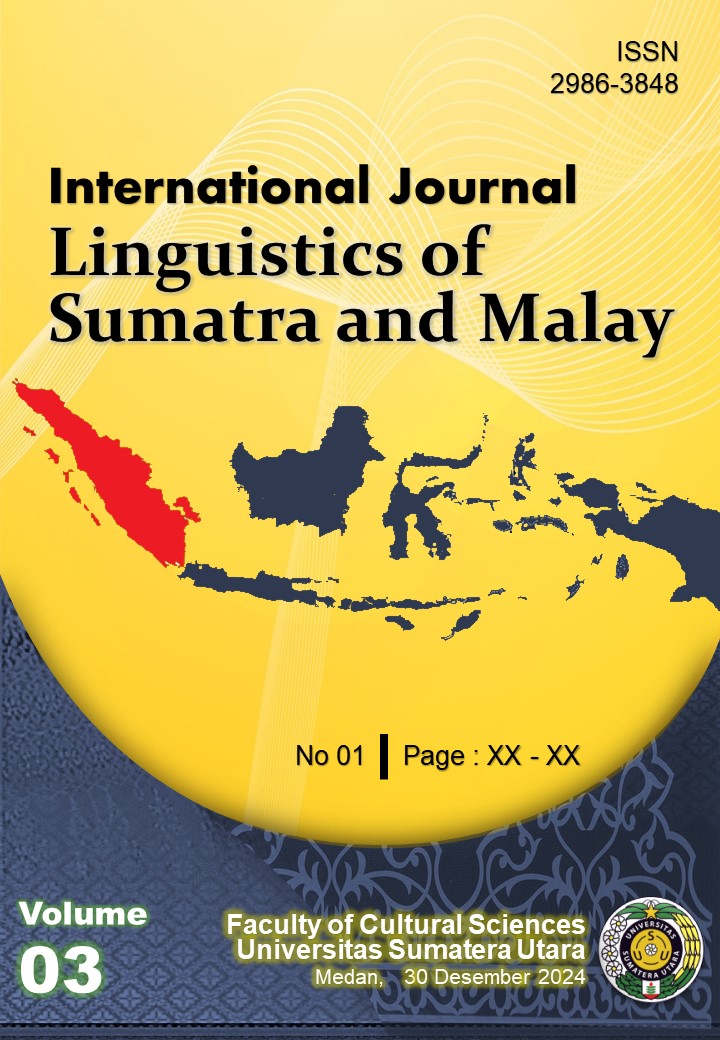The Function of Language at Medan Train Station: Linguistic Landscape Study
DOI:
https://doi.org/10.32734/ijlsm.v3i1.16457Keywords:
The Function of Language, Linguistic Landscape, Medan Train StationAbstract
This study explores the language functions of the linguistic landscape at the Medan train station, focusing on its symbolic and informational roles. Using a qualitative descriptive approach through observation, interviews, and documentation techniques, the research highlights the distinct characteristics of the linguistic landscape in this location. The findings reveal a dominance of monolingual Indonesian, which facilitates easy comprehension of billboards and signage for the majority of the population. Informational functions are well-developed, effectively serving to guide and assist users in navigating the station. Additionally, the inclusion of logos, such as the PT KAI logo, emphasizes the credibility and official nature of the messages conveyed. However, the research also identifies a significant underutilization of the symbolic function in the linguistic landscape, with limited representation of local cultural or linguistic elements. This gap is influenced by the public's mindset and a lack of attention to the potential of linguistic landscapes as tools for cultural preservation and identity expression. The study contributes to a deeper understanding of language usage patterns in public spaces and underscores the need for greater integration of symbolic elements, such as traditional scripts and multilingual signage, to enrich the cultural representation and literacy of the community. These findings hold implications for improving the design and functionality of billboards at the Medan train station, ensuring they serve both practical and cultural purposes for diverse users.
Downloads
References
Asmara, R. (2018). Struktur dan fungsi bahasa dalam wacana iklan pasta gigi Sensodyne. Pertemuan Ilmiah Bahasa Dan Sastra Indonesia, 459, 459– 470
Azis, A., & Juanda, J. (2017). Kohesi Gramatikal: Kajian Keutuhan Wacana Tugas Mahasiswa Pendidikan Bahasa Dan Sastra Indonesia, Fakultas Bahasa Dan Sastra, Universitas Negeri Makassar. Bahasa Dan Seni: Jurnal Bahasa, Sastra, Seni Dan Pengajarannya, 45(2), 170– 180. https://doi.org/10.17977/um015v45i22017p170
Benu, N. N., Artawa, I. K., Satyawati, M. S., & Purnawati, K. W. (2023). Local language vitality in Kupang city, Indonesia: A linguistic landscape approach. Cogent Arts & Humanities, 10(1), 2153973.
Erikha, F. (2018). Konsep Lanskap Linguistik Pada Papan Nama Jalan Kerajaan (Râjamârga): Studi Kasus Di Kota Yogyakarta. Paradigma, Jurnal Kajian Budaya, 8(1), 38. https://doi.org/10.17510/paradigma.v8i1.231
Gorter, D. (2006). Further Possibilities for Linguistic Landscape Research Globalisation and the Spread of English Terminology: Etymology and a Neologism. 81–89.
Gorter, D. (2021). Linguistic landscapes and trends in the study of schoolscapes Linguistics and Education(2017),http://dx.doi.org/10.1016/j.lin ged.2017.10.001
Koschade, A. (2016). Willkommen in Hahndorf: A Linguistic Landscape of Hahndorf, South Australia. International Journal Of Humanities And Cultural Studies, 3(1), 693-699.
Noor, W. K., & Qomariyah, U. (2019). Jurnal Sastra Indonesia Impian. 8(2), 103–110.
Nupus, H. (2022). Kebıjakan Bahasa dalam Lanskap Linguistik di Era Super- Diversity Bahasa Asing ( Bahasa Inggris ) di Ruang Publik. 8(2), 278– 283. https://doi.org/10.30653/003.202282.238
Nur Wijayanti. (2020). The Linguistic Landscape of Educational Tourism in Mojokerto Thesis By: Eka Widya Nur Wijayanti. Oktavianus. (2021). Lanskap Linguistik Bahasa Tulis Di Ruang Publik Dan Upaya Pencegahan Penularan Virus Korona. Jurnal Lazuardi, 4(1), 43–56. https://doi.org/10.53441/jl.vol4.iss1.
Pasaribu, G. R., & Salmiah, M. (2024). Linguistic Landscape in Kualanamu International Airport. LingPoet: Journal of Linguistics and Literary Research, 5(1), 1-6.
Salah, M., & Syarat, S. (2021). Deskripsi dan konfigurasi lanskap linguistik di museum. Sugiyono, 2021. Metode Kualitatif. Bandung: Alfabeta, CV
Widowati, A. (2020). Fungsi Bahasa Pada Dongeng Karya Charles Perrault Dalam Perspektif Halliday. 1-82.
Downloads
Published
Issue
Section
License
Copyright (c) 2024 International Journal Linguistics of Sumatra and Malay

This work is licensed under a Creative Commons Attribution-ShareAlike 4.0 International License.
All articles published in the International Journal Linguistics of Sumatra and Malay (IJLSM) are licensed under the Creative Commons Attribution-ShareAlike 4.0 International License (CC BY-SA 4.0).
This license permits anyone to:
-
Share — copy and redistribute the material in any medium or format.
-
Adapt — remix, transform, and build upon the material for any purpose, even commercially.









